Tamiya | 1/32 Mitsubishi A6M5 Part 2
Reviewed by Rato Marczak
Tamiya Mitsubishi A6M5 "Zero" (kit #60309) Part 2 (Part 1)
ENGINE
The engine is one of the last major sub-assemblies to be added to the model, after the instructions. It goes along steps 37 to 45. It is really complete, including the carburetor area behind the second row of cylinders.
The cylinder rows are beautifully molded in halves. Both pushrods rings are separately molded. The cowling supporting frames are also included, and they are not fake parts like we generally find in many large scale models. They depict accurately the prototype, so you can even leave the cowlings off the model.
You have the choice of open (parts C26 and C11) or closed (parts C3 and C12) cooling flaps. In both cases, they are molded altogether - no boring cementing plate by plate. Once finished, the engine is mounted on the tubular strut ahead the firewall. Take a look on the final result in one of the photos below, showing the magnificent work of modeler Bernard Schrock with this kit.

Engine cylinders.
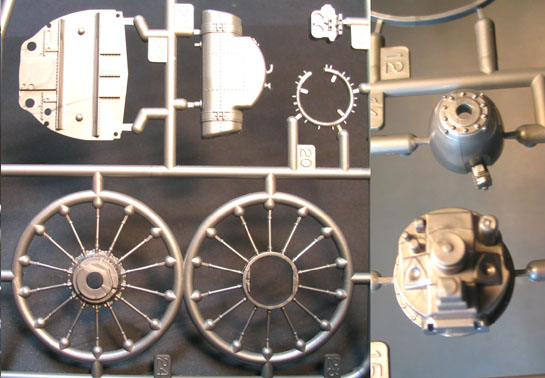
Engine details: firewall and oil tank, ignition ring, reduction case and carburetor, pushrods.
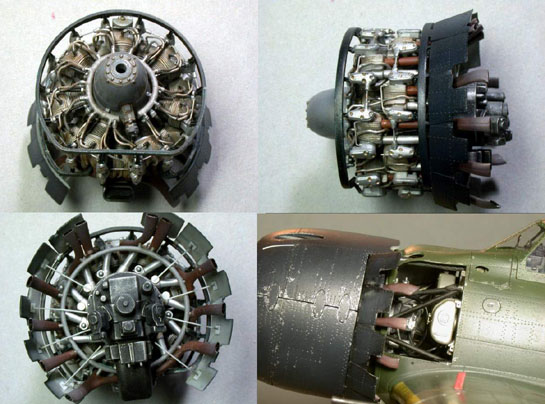
A splendind work accomplished by modeler Bernard Schrock (photos by him, I guess). Compare with...

...Sakae engine in the Kanoya Naval Aviation History Museum (photo credit unknown).
The propeller comes in a single piece, and you have to add the counter balance weights. The cowling is very well molded in two halves. They just click in place. Tamiya has paid extra attention to the rivet detail here.
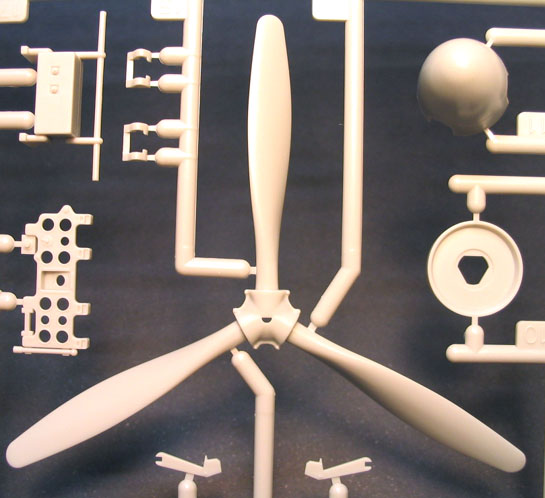
Propeller and spinner. Note the control panel on the left.
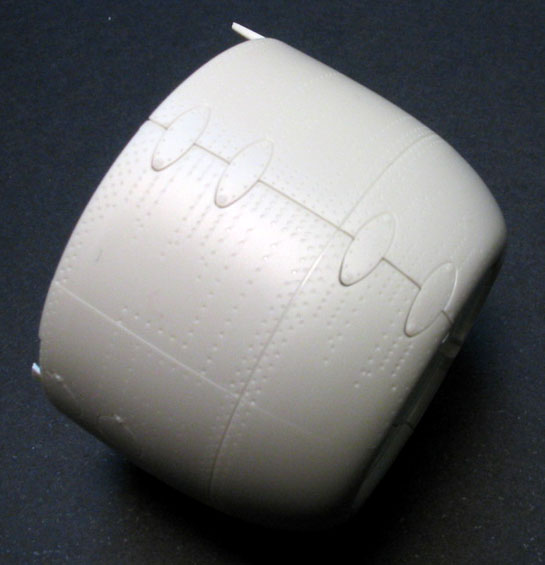
Both cowling halves test fitted. Note the petite surface details.
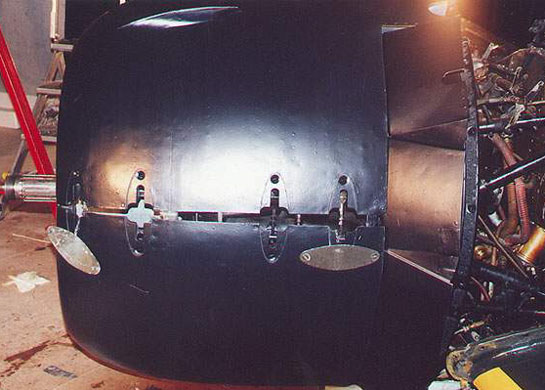
Auckland War Memorial Museums A6M3 model 22, showing the cowling fasteners (photo by David Stewart).
The Zero had an array of actuator arms to push/pull the cowling flaps. The photo below shows clearly these arms between the exhaust stacks. Note that, in spite of the separated flaps, and its very convincing thickness, Tamiya´s kit doesn´t bring any part representing the arms. On the other hand, the final appearance of the fuselage vents behind the engine´s accessory part is very convincing.
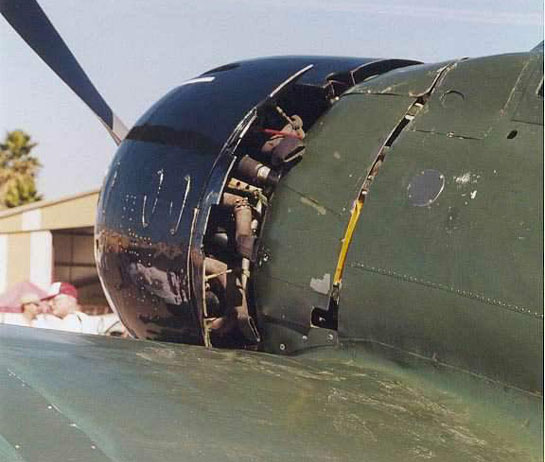
Note the correct arrangement of the cowling flaps and exhaust stacks in this preserved A6M5 (photo credit unknown).
LANDING GEAR
The landing gear of this kit is a little working marvel, as explained in steps 32-36 of the assembly instructions. Besides the rubber tires and hoses, the main struts are retractable and the suspension is spring loaded. The whole assembly is strongly fixed by metal screws, and cleverly engineered. Tamiya managed to inject the plastic around metal oleos. If carefully removed from the sprues and cleaned, these parts won´t need any paint, I guess. The retraction operation of the main landing gear parts is done by hand, simply pushing the gear leg to the wells. The inner doors are automatically closed by the tires, just like the real thing, as Tamiya beautifully replicated the corresponding armed mechanism (see steps 20-22). The lowering operation, on the other hand, requires the removal of the wing cannon leading edge panel. A provided key is inserted in a slot and turned in order to lower the leg. This avoids your nails scratching the painting to lower the undercarriage.
The retraction of the tail wheel is also done by hand. To lower it, you pull down the arresting hook, insert another key in a slot in there and turn it.
These movable parts are the best I´ve ever seen in a plastic model, but I´m not sure the paint coats will stand the friction on the contact areas. Anyway, I guess a serious modeler won´t be retracting/lowering the landing gear every time...
The wheel bay doors are a bit on the thick side, as well as the ribs in the wheel wells. I found a few ejection pin marks spotted in areas that will be visible after the assembly. Another nice touch are the torque links, which come as separated parts and work like the prototype. The assembly is just a matter of clicking them in place.
The instructions point out where to apply the grease provided in a tube. I don´t think this is a good idea, because it can slowly migrate with time and smear the surrounding painted areas. In addition, the area will be permanently attracting dust.
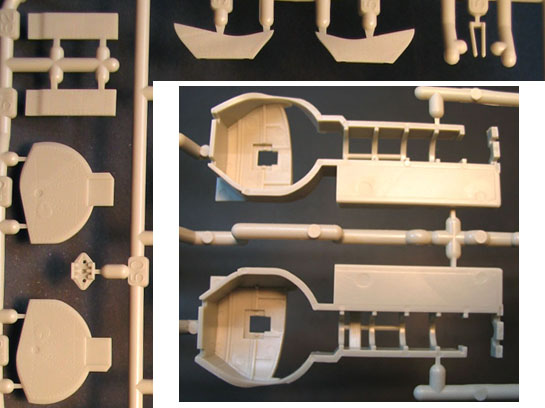
Landing gear parts. Lots of ejection pin marks
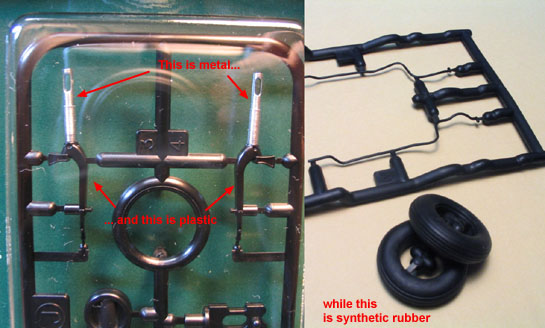
The main wheel parts and the tail wheel strut.

Tail wheel yoke. On the right, the real part from an A6M3-22 in the Auckland War Memorial Museum (photo by David Stewart).

Main landing gear of the A6M5 in the Kanoya Naval Aviation History Museum (photo credit unknown).
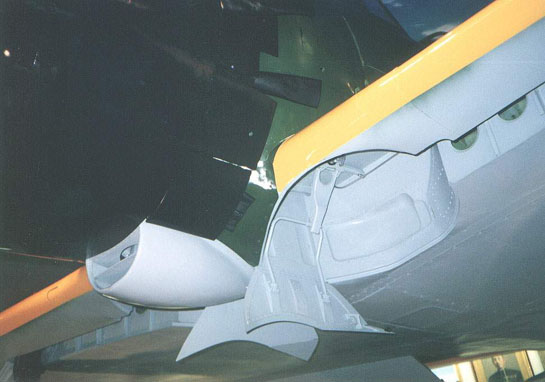
Wheel bay of the A6M5 in the Kanoya Naval Aviation History Museum (photo credit unknown).
CLEAR PARTS
There are 18 clear parts in sprue F. Canopy components, wings and fuselage lights, gunsight and the "glasses" for the control panel dials. They are crisply molded, and won´t even need the traditional Future bath. The only part that will give some work is the Type 98 optical gun-bombsight. It is a very prominent item in the cockpit and I included a pic below that may be of some help when painting this part.
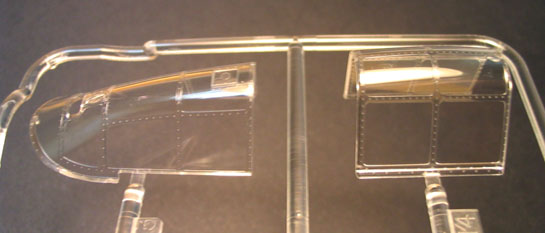
Clear parts: rear and sliding canopy parts.
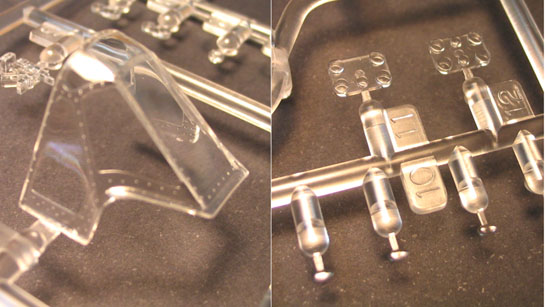
Clear parts in detail: Windscreen, control panel glasses and lights.
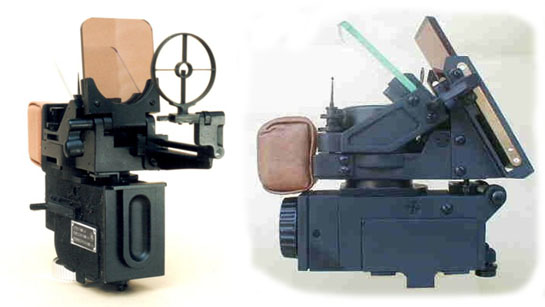
Type 98 gun/bombsight.
SOME OTHER DETAILS
There are many other details not mentioned in the text, and of course I won´t mention them all. It is worth to cite the wing and the fuselage armament. They are fairly detailed, but will be mostly hidden anyway. No doubt some detailers will open a panel here and there to add more bits.
DECALS
The decal sheet is typical of Tamiya. A bit thick but based on previous experiences they will respond well to setting solutions. There are three versions to choose from. All of them pretty much identical in IJN dark green over IJN light gray. Perhaps the only disappointment of the kit...
However, the sheet is very well printed and in perfect register. Note that the control panel instruments are printed reversed (the adhesive side will be visible) to be placed on the back of the clear dials. Pay attention on the printed arrows as they indicate the upper side of each instrument.
Some variations can be found in aftermarket items. Right now I recall Eagle Strike sheet #32018, which brings some more colorful options. The fact is that unless you are planning to model those captured Zeros evaluated by T.A.I.C., or an aircraft in surrender markings, the A6M5 does not share the same wide range of schemes of its previous versions.
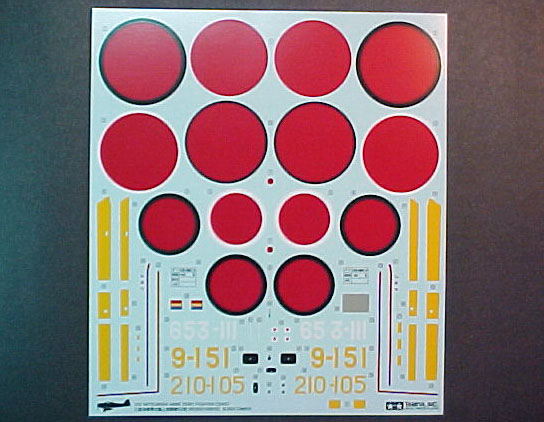
The decal sheet
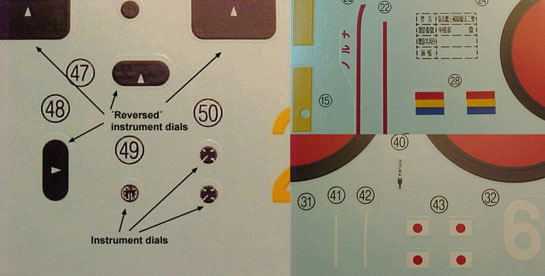
A zoom on the decal sheet. Note the "reversed" instrument faces.
PROBLEMS
I said the kit is almost perfect. Some time ago Ryan Toews has compiled a list of notes on this kit for j-aircraft. I failed to locate the link after j-aircraft was overhauled, but he kindly allowed me quote his observations here (thank you Ryan). The man is really an expert on the subject, and the points below will help you to built an even more authentic replica.
"From what Jim Lansdale has related elsewhere, the Mitsubishi built A6M5s retained an overall paint job of Mitsubishi's variant of semi-gloss Hairyokushoku gray-green FS 6350, albeit possibly no longer applied over are-brown primer. The upper surfaces with subsequently camouflaged with a semi-gloss or matte dark green close to FS 4052. Nakajima also retained a variation of semi-gloss Hairyokushoku similar to FS 4201 on the undersides of the A6M5s it manufactured. The upper surface camouflage this company applied was a semi-gloss or matte dark green with a value of FS 4077. It is presumed that the fabric-covered surfaces were still painted in a mid-gray shade of FS 6314, except of course where the upper surface green paint was to be found. The cowling was painted with a semi-gloss blue-black color on Mitsubishi built planes and a semi-gloss black on Nakajima built ones. The white gun alignment lines on the upper cowling were probably not present on the earlier Mitsubishi built A6M5s such as 9-151.
In the following the numbers refer to the sub-sections in the Tamiya kit instructions:
Step #1
- The cockpit interior should be FS 4095 for a Mitsubishi A6M5 and FS 4255 for a Nakajima built Model 52.
- The rivets on the rear cockpit deck should in fact be raised, they were not flush.
- The cockpit decking should be black on the Nakajima A6M5 but is the same FS 4052 green as the rest of the upper - surface camouflage green on the Mitsubishi Type 52.
- The cutout for the loop antenna just behind the rollover pylon should be opened up to measure 5.5mm x 2mm (180mm x 60mm). The loop antenna should be mounted to a base that is inside the fuselage and allows the antenna to extend through the opening.
- Part E3 can only be found on the early A6M2 and therefore should be left off. However, the hemispheric lamp should be attached just below E26. It is overall natural aluminum.
Step #4
- Mitsubishi did not paint the steel parts in the cockpit black as was found in the Nakajima planes. Thus the black paint applied to the points where parts E35 and E36 attach should be black only in the latter·s Zeros.
- The lamp at the front end of E29 should be overall aluminum.
- Parts E35 and E36 should be black on Nakajima planes and cockpit interior green on those built by Mitsubishi. In both cases the knob at the end should be black.
- Part E81 has no black on its handle in either manufacturer·s case.
Step #5
- The buff painted ·pencil holder· was not found on all aircraft and should be considered optional
- The fire extinguisher control box sitting on the small shelf at the rear of part E22 should be removed along with the shelf on all Mitsubishi A6M5s built before early December 1943 (starting with s/n 4274) which almost certainly includes A6M5 9-151. The box may have been in this position once Mitsubishi began installing such equipment but Nakajima installed this control box against the left side of the rear bulkhead (part E34) from the start. In all cases, though, the shelf should be removed.
- A ·bicycle chain· needs to be attached leading backwards from part E31.
- Part E82 should have a dark blue handle, not black.
- Part E38 should have instruments in all four cutout holes.
Step #6
- On the right floor of the cockpit is a rectangular box with three handles on top of it. This box should have round lightening holes in the sides of it.
- In front of this box is a fitting that was deleted in the production of the A6M3. It should be completely removed flush with the cockpit floor.
Step #8
- As mentioned above Mitsubishi did not paint the steel fittings in the cockpit black. Thus the painting instructions for parts E5, E6, E12, E13, EE72 and the crosspiece to which these attach apply only to Nakajima planes.
- Part E23 should be black or the cockpit interior color for Nakajima or Mitsubishi respectively.
- A white colored bungee cord should be fitted over the two part E23s from about one third of the way back from the seat on parts E12 and E13.
Step #9
- The switch in the middle of the lower left tier of instruments should be black.
- The crank on part E25 should be yellow.
Step #12
- The machine guns were more likely to be a metallic gray color rather than black at this stage in the war.
Step #20
- The interior side of the small wheel well doors should be aotake for a Nakajima Zero and underside Hairyokushoku for a Mitsubishi built plane. In either case the U shaped arm should be black.
- The small folding rear corner of each door should be bent over unless one is going with the folding landing gear function.
Step #22
- The functioning landing gear really compromises parts E15 but they should be aotake for a Nakajima Zero and underside Hairyokushoku for a Mitsubishi model. If the folding landing gear option is not used these parts should be rebuilt.
- Round lightening holes should be drilled between the ribs in both the front and rear of the outer section of the wheel wells.
- Each well should have the brake lines added and the left well should also include the two lines running out to the pitot tube.
- Detailing the wheel wells should also include the addition of raised rivets throughout.
Step #24
- The interior side of parts B12, B13 and B14 should be underside Hairyokushoku for both a Mitsubishi and a Nakajima Zero.
Step #28
- The photo-etched oil cooler should be mounted at an angle in the oil cooler intake.
Step #30-31
- The use of moveable ailerons means that the aileron actuating rods cannot be included. If this function is forgone add the rods from parts B10 into the wing.
Step #32
- Parts H2 and H3 should be painted with aluminum paint.
- The roughly rectangular piece molded as part of the lower landing gear and to which the lower wheel well cover is attached should not be painted black but is actually finished in underside Hairyokushoku.
Step #33
- The vinyl tires should not have any tread molded into them.
- Parts E51 and E52 should not have a ·step· in the lower outer surface. These were actually each a single sheet of aluminum with small ·angle iron· strips fitted along the edges.
- The interior side of the wheel wide covers should be underside Hairyokushoku for both Mitsubishi and a Nakajima Zeros. This includes both parts E52 and E64 and parts E51 and E65.
Step #34
- While the wheel well cover weight indication decals (28) supplied in the kit are correct for the Mitsubishi built A6M5. Nakajima used a simpler scheme that used only red over blue stripes or a single red stripe.
Step #36
- The small hub of the tail tire should be natural aluminum.
- The tail gear should have a canvas covering fitted to it. The canvas was probably tan, green or black.
- Only the attachment fitting and the actual hook of the tail hook should be black. The shaft of the hook should be the same shade of Hairyokushoku as the underside of the plane.
- The interior of the tail hook well should also be the same color of Hairyokushoku as the rest of the underside.
Step #37-42
- Several errors exist in the engine. The first of these are the missing baffles that fit between at the end of each cylinder. Eduard includes these baffles in their photo-etch set.
- Secondly, parts D12 and D13 should be affixed to the engine by small arms attached to each cylinder just below each rocker box cover.
- Starting with A6M5 s/n 4550 built in mid-February 1944 the lower exhaust pipes were shortened in length 80mm. As this is about the time that Nakajima began production of the A6M5 it can be assumed that any Nakajima Model 52 had the shorter exhaust. Thus for an early model Mitsubishi A6M5 parts C5, C6, C23 and C24 should be lengthened by 2.5mm.
- The engine painting instructions are almost all incorrect. Thus the engine colors described in a TAIC wartime metallurgical report on a captured Sakae 21 are given as follows
- Cylinder head - black paint
- Cylinder barrel - black paint
- Rocker box cover - black paint
- Push rod housings - black paint with NMF fittings at each end
- Baffles (between cylinders) - black paint
- Intake manifold - black paint
- Crankcase - greenish-gray pain (the nose section is held in place by 14 NMF bolts)
- Blower case - gray paint
- Gear case - gray-green paint
- Gear oil pump housing- gray paint
- Fuel pump case - black paint
- Fuel pump support - gray-green paint
- Gun synchronizer housing - gray paint
- Ignition system conduit tubes - gray paint
- Ignition system cables - black leatherette covering
Step #43
Step #46
- A U shaped handle should be added to the inside lower right front and the vertical latching rod mechanism to the left front of the sliding canopy.
Step #47
- Part C19 should be the same green as the upper camouflage of the plane.
- Part A11 should be black and the rivets should be raised, they were not flush.
Step #48
- The propeller colors are correct for a Nakajima aircraft but early Mitsubishi A6M5s retained the earlier natural aluminum blades with flat dark brown (FS 0059) painted propeller backs, a single red warning stripe, and aluminum painted spinner. 9-151 probably was still in this earlier scheme.
Step #50
- The radio antenna wire should run back to a bungee cord that is looped through a small hole in the rudder. This cord was twisted to prevent it vibrating in the slipstream and was connected to the antenna wire with a white glass insulator.
Step #52
- A filler cap needs to be added to the top front of part E67. It probably should be painted red.
Later during our conversation Rayn also added:
- The canvas cover over the tail wheel well should be a dirty olive drab color. This can be seen on at least one wartime color photo.
- The outer edge of the tail wheel wheel is specific to a Nakajima built Zero.
- The part of each wheel strut that curves around the wheel should have a weld seam on the outer radius of the strut.
- Weld seams should be added to each of the exhaust pip
FINAL COMMENTS
Well, this is not a weekend project. I recommend you to study carefully the instructions before starting. To follow the instructions is another good advice.
In my mind, Tamiya would sell more Zeros had the folks there released an A6M2, since the type fought all the important battles during the early years of the war in Pacific (Pearl Harbor, Philippines, Midway, Guadalcanal, Coral Sea and the Solomons campaign). Moreover, the A6M2 had many more camouflage variations in comparison to the A6M5. This is reflected in all three decal versions offered, as they are very similar. On the other side, the A6M5 was the last version of the Zero to be used by the IJN in good numbers, and many Japanese aces closed their kill lists - or died - in this mount.And a late Zero is a late Zero: lots of paint chipping. Weathering is an important step in the present case, and if you plan to go for it, you probably will spend way more time doing it than airbrushing the basic airframe colors. And by the way, along with this kit Tamiya released the spray cans AS-2 (IJN Light Gray) and AS-21 (Nakajima IJN Dark Green). I´m not aware of the release of these colors in their classic acrylic or enamel little bottles.The Zero is very well documented in the literature, and if you are planning to add something to the model the Aero Detail and the Maru Mechanic books on the subject are excellent choices. A visit to the folks at j-aircraft is always worth too. Here some links to recent LSP articles on this model:-
- Bobby McElroy Zero.
- Rick Cotton Zero.
- Flip Hendrickx Zero.
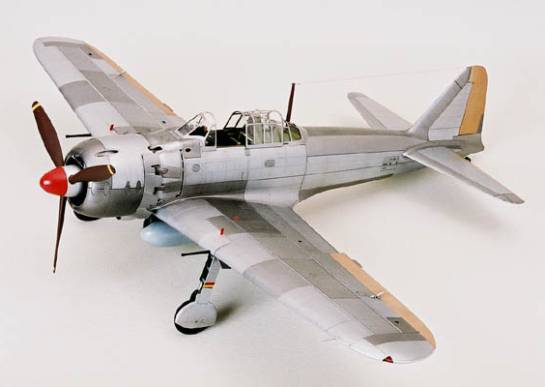
Tamiya 1/32 Zero built by LSP contributor Matsumoto Naoto. Interesting finish, huh?...
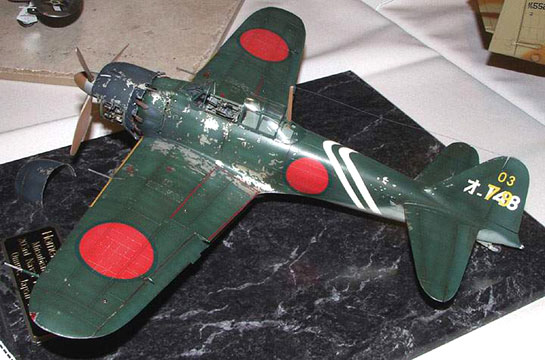
An impressively weathered Tamiya 1/32 Zero built by Brian Criner.
SUMMARY
This kit is really excellent. A proof of it is in the fact that just a few aftermarket items appeared to improve it. The Tamiya Zero made this sort of thing is simply unnecessary. Eduard and CMK gave their contributions but, except for decals and pre-cut masks, I don´t recall other manufacturers investing in detail sets for this bird. In some sense, this model is launching a new standard for 1/32 models, and we can only hope that more WWII subjects come up with the same quality. If it is not a perfect model, it is probably the closest you can get of it. Highly recommended.
© Rato Marczak 2003
This review was published on Saturday, July 02 2011; Last modified on Wednesday, May 18 2016
